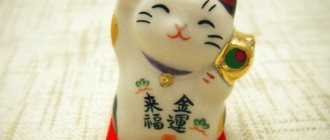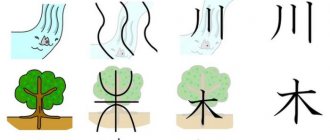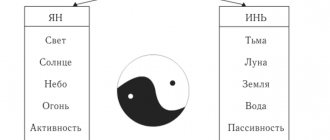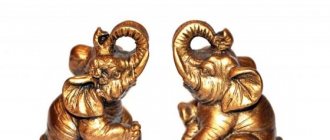The fish living in the water has always been interpreted as a lunar symbol, personifying life, love, fertility and wealth. In many cultures around the globe, fish were sacrificed to the underground gods, and dishes prepared from it were eaten on a certain day of the week. The property of the fish breeding with eggs to produce countless offspring made it an attribute of the goddess of love and fertility Aphrodite; it became a symbol of pregnancy and female fertility. Since the water element was dangerous and inaccessible to humans, fish has always been associated with mystery. In addition, in antiquity, fish were considered companions of the sea god Poseidon.
Fish and anchor - symbolism of the first Christians. Relief in the Roman catacombs.
The first Christians in the Roman catacombs. Painting by J.-E. Lezhnev
In ancient China, fish was a symbol of love, abundance, fertility and happiness. Two fish symbolized two happy spouses. In India, it was believed that the god Vishnu, in the form of a fish, saved the world from the flood. In Buddhism, the fish was associated with unlimited freedom, and one who wants to follow the Buddha must be like a fish, freed from passions and attachments.
In European alchemy, fish denoted a secret substance, and a pair of fish in the alchemical picture of the world, swimming in the same river, symbolized a solution of sulfur and mercury.
K. Witz. Wonderful fishing. After a huge catch, Christ told his first disciple, the fisherman Peter: “Do not be afraid; From now on you will catch people.”
A. Elsheimer. Tobiah and Archangel Raphael. The non-canonical book of the Old Testament “Tobit” describes the joint journey of the young Tobius and the Archangel Raphael in search of a means of healing the young man’s father. The archangel helped catch a fish, with the help of which Tobiy drove out demons and cured his father of blindness
"X-ray" rock carving of a fish totem, made by Aboriginal people on the Arnhemland Peninsula - at the center of ancient Australian culture
Constellation Pisces
One day, the daughters of the soothsayer Nereus, the Nereids, were walking along the seashore. One of them, the beautiful Galatea, somehow fell behind the host of sisters and met Akidas, the tall and stately son of Semetis. Galatea and Akid fell in love with each other. However, Galatea had another admirer - the terrible Cyclops Polyphemus, who pursued her everywhere. The girl was very afraid of Polyphemus and tried to avoid him. One day Polyphemus noticed Akidas and Galatea secluded in a grotto. He rushed towards them, and from his stomp the earth trembled and the sea became agitated. In fear, the lovers rushed into the sea and turned into two fish, and as a sign of love, a ribbon appeared between the fish.
Constellation Pisces. Illustration from the astronomical atlas “Uranography” by J. Hevelius
S. Lambert. Venus and Cupid
LiveInternetLiveInternet
There are symbols that accompany us throughout our lives and mysteriously influence it, although we do not always feel it. Here is one of such symbols. As children, we listen enchanted to the fairy tale about a goldfish that grants any three wishes, but also rewards what we deserve.
As a reward for his goodness, Emelya receives a pike as an assistant, thanks to which he marries the king’s daughter. A fairy tale knows a miracle fish: a woman who tastes it gives birth to heroes. The hero may be swallowed by a huge fish, but he always returns transformed: he begins to understand the bird's language, finds riches or reveals hidden secrets; or maybe in the belly of a fish you can be transported to another world. In our youth, reading the myths of Ancient Greece and Rome, we learn that fish, symbolizing the power of water, are attributes not only of the sea deities Poseidon and Neptune, but also of the goddesses of beauty and love Aphrodite and Venus, born from the foam of the sea. As the element of water, fish are associated with the Mother Goddess, the progenitor of all life.
Fish dishes were offered as sacrifices to all the gods of the underworld and the lunar goddesses of water, as well as love and fertility. This is related to the Syrian goddess Atargatis - her son Ichthys was a sacred fish - the Assyrian-Babylonian Ishtar, the Egyptian Isis, the Roman Venus, the Scandinavian Freya. In their honor, fish dishes were eaten on Fridays. Ancient Indian myths say that the god Vishnu turned into a fish during the great flood and saved the forefather of people Manu. In ancient China, fish was considered a symbol of happiness and abundance. In Japan, different types of fish are associated with different meanings. For example, a carp that can overcome oncoming currents and waterfalls is the embodiment of courage, endurance and endurance. And on Boys' Day, which falls on May 5, banners with carps embroidered with silk threads are hung in front of houses where there are boys. Entering the age of maturity, thinking about the meaning of life, trying to find our purpose, we sometimes turn to astrology, alchemy, and religion. And here new discoveries await us. As the 12th sign of the Zodiac, Pisces marks the end of one cycle and the beginning of the next. Those born under the sign of Pisces are characterized, for example, by the desire for brotherhood and peace, perfection, courtesy, “painstaking effort,” as well as “indomitable fertility.” Fishermen and sailors are often born under the sign of Pisces. In alchemy, two fish in one river symbolize primary matter and two elements - sulfur and mercury in dissolved form. For the past 2000 years, humanity has lived in the Age of Pisces, which began with the birth of Christ. It has been observed that if the first letters of the words “Jesus Christ, Son of God, Savior” (written in Greek) are added together, the Greek word IXOYS, “fish” is formed. The image of a fish, which became a symbol of Christ, is found on seals and lamps in Roman catacombs and on sarcophagi. It was considered a secret sign of the first Christians, who were in a hostile environment of pagans. There is also an analogy between fishing and converting people to a new faith (hence the "fisherman's ring" worn by the Pope). Christ called the apostles “fishers of men” and his converts “fishes.” As in many world and earlier religions, fish with bread and wine in Christianity is a sacred food. It is not for nothing that we often see fish in images of the Last Supper. The Christian symbol of fish combines not only astrological, but also pagan meanings. Even in ancient times, people associated fish, an inhabitant of the water element, with the origin of life on earth. Fish could bring silt from the bottom of the primordial ocean, and from this silt the earth was created. And it could serve as a support for the earth, which in this case rested on one, three or seven fish swimming in the world’s oceans. As soon as the fish waved its tail, earthquakes began. Fish was also connected with the world of ancestors. Many peoples believed that when a person dies, a person’s soul moves into a fish, and in order for the soul to reincarnate in a child, one simply needs to eat the fish. Fish also participated in rites associated with initiation into adulthood. Entering the belly of the “fish” (entrances to special huts where initiatory rites were held were often made in the form of the mouth of a fish, whale or crocodile), the neophyte symbolically died, entered the kingdom of the dead, and then, coming back, was symbolically born to a new life. Now, enriched with new sacred knowledge (after all, the dead know more than the living), he could enter adulthood. Petroglyphs, rock paintings, numerous stone and metal decorations in the form of fish from archaeological excavations are news to us from those distant times. Even today, without knowing all these details, like ancient people, we surround ourselves with images or stylized figures of fish. And according to psychologists, our dreams are quite “densely” populated by fish, which act as a symbol of the unconscious and creative inner worlds of our soul. This means that this ancient symbol still lives, and with its help we can understand ourselves - we just need to engage in dialogue with the fish.
Known. that for many peoples Pisces is the totemic creature of their ancestors. Fishes in the folklore of different nations.
There is such an abundance of fish names in ancient Russian tales and fairy tales that we can say with complete confidence: the population of ancient Rus' knew the inhabitants of their reservoirs very well. They distinguished peaceful fish well from predators, describing the characteristics of pike, ruffe, crucian carp, ide, bream, burbot, perch, sturgeon, roach, salmon, whitefish, catfish, kaluga and others. Many peoples used fish as symbols, some of them were especially highlighted. Salmon symbolized abundance among the American Indians, Irish and Finno-Ugrians. The carp was revered in China, and in Japan, bred koi carp with bright red spots symbolize strength and courage, as well as tenacity in the fight. Among many ancient peoples of Asia, carp played a special role in shamanic rituals when expelling evil spirits. Among the islanders, the shark was an image of evil and death. The main temples of Stribog, as is known from the ancient Slavs, were located on islands near the mouths of rivers, where fishermen and merchants often stopped. Berezan at the mouth of the Dnieper-Bug estuary was considered one of these islands. Before leaving for the open sea, Russian ships approached the island to bring rich gifts to Stribog. After all, according to legend, Stribog, together with Perun, commanded thunder and lightning. Stribog had many sons and grandchildren. They were the winds - Whistling, Podaga and Weather. Whistling is the elder wind, the god of the storm, lives in the mountains in the North, Podaga is a hot, drying wind. He lives in the south in the desert. Pagoda - warm, light breeze - god of pleasant weather. Until the 16th century not only sailors, but also scientists believed that a giant crayfish lived in the sea, devouring fishermen who fell into the sea. “During one of his trips to the Land of Gold (Indonesia), Captain Ismailuya approached land near Almeri (northern part of the island of Sumatra ), since he needed to stop the ship, which was damaged. When the sailors dropped a large anchor, the ship, for some unknown reason, continued to sail further. “Come down the anchor rope and find out what’s going on!” - Ismailuyya ordered the diver. But the diver, before diving, looked into the depths and saw that the anchor was clamped between the claws of the crayfish, which, playing with it, was dragging the ship. The sailors began to shout and throw stones into the water; finally they pulled up the anchor and dropped it in another place.” How similar this fairy tale, born on the shores of the Indian Ocean, is to the Oceanic myth about a giant mollusk swallowing ships with their entire crew! Both tales reflect, albeit in a fantastic form, the countless difficulties and dangers that ancient sailors faced. An amazing story about ships that almost became victims of a monstrous cancer back in the 10th century. Buzurg ibn Shahriyar told in his book “Wonders of India”. “People believed that the God of Timbabantu sent the fishermen a good catch, but he also drove the fish away from the shores. Fears surrounded the village on all sides. Fear lurked in the thicket of forests, fear crawled in the swamp mists, fear lay in wait for the traveler everywhere. Fear moaned, screamed, sobbed, snapped its jaws, roared, meowed in the middle of the dark night, rustled leaves, howled like a crushing storm, rumbled with rolling thunder, blazed with lightning... And the sacrificial fire blazed, the bodies of burned people and animals crackled and hissed. Timbabantu devoured victim after victim and was insatiable, demanding more and more victims...” The legends of our ancestors about the underwater world appeared in the 6th millennium BC. This was the period of the birth of the Slavic epic itself, which stood out from the epic of the Indo-European peoples. From this period, some archaeological monuments have reached us. It was then that the legend of the Sea Serpent was born among the Proto-Slavs. The Black Sea serpent lives at the bottom of the sea in a white stone palace - miraculously, those chambers are decorated with amber, corals, and pearls. He is surrounded by fierce guards - crab crayfish with huge claws. There is also a catfish with a big mustache, and a thick-lipped burbot, a lip-slapper, and a sturgeon, and a toothy pike, and a giant sturgeon, a toad with a belly like a jug, and the king of all fish is the Whitefish! Dolphins serve the Black Sea, and mermaids sing for it, play ringing harps, and blow huge shells. The sailing Rus conquered the sea elements in ancient times. They mastered not only the Black Sea, but also the Mediterranean. The god of the winds, Stribog, was revered by sailors and fishermen. Having turned into the Stratim bird, he could summon and tame the storm. The Russians invented the rudder, anchor and sail. They knew well the habits of sea fish, some they caught with seines, and some with fixed nets. The period of epics and sacred texts about fish was from the middle of the second millennium BC. e. and lasted until the 3rd-4th centuries AD. e. From this “time of ancient kingdoms” the names of many leaders and princes are remembered, and numerous archaeological sites complement the history of this era. Various peoples have preserved many epics in which fish and fish-like monsters played a significant role. Among the peoples of the North, the burbot personified the underground kingdom. After all, it spawns and shows its activity - zhor, opening a “terrible gape” for this when the polar night reigns in the Arctic. “The frosts are bitter outside, but the burbot is having more fun,” says a popular proverb. This is how modern fishermen talk about winter burbot fishing: “In the darkness, from under the ice, you drag some kind of monster, like a water goblin, slippery, covered with sticky mucus, which makes it impossible to hold it in your hands. A burbot pulled out onto the ice in the bitter cold flutters, moves, twists, raises its big head and opens its mouth...” And one could imagine our ancestor who went out on the ice to fish at night, after visiting a local sorcerer or priest. More often, prayers were said at the sacrificial place for good luck, and enemies were feared. These scenes were preserved in the epic of the northern peoples. In “Kalevala” many scenes are associated with the fight against underwater monsters, represented either by pike or burbot. To win the favor of his future mother-in-law, the mistress of Pohjema, the groom Ilmarinen must do many good deeds - plow a snake field, defeat a bear and a wolf, and, finally, catch and deal with a huge fish from Tuoni or Mana - the underworld, personifying evil forces. News about global events that took place on Earth comes to us, descendants, in the form of legends and myths. For example, the World Floods. In the myths of different peoples, fish acted as life saviors. Some historians believe that in human memory there were five great floods: “Platonovsky” (7500 BC), “Atlantic” (5500 BC), “Worldwide” (3100 BC), “ Deucalion" (1400 BC) and "Biblical" (800 BC). Floods are associated with earthquakes, melting glaciers, outbursts of water accumulated in valleys, volcanic eruptions and the fall of celestial bodies. All nations where myths about floods exist, in Iran, Transcaucasia, Syria, Turkey, Palestine, had a cult of fish as the savior of people and the Earth. We find echoes in the texts of various documents that have survived to this day. The Sumerians have a text translated as “House of the Fish.” This is a monologue in which it is said that a special house is being built for the safety of the fish - a temple pool. Temple fish pools are an attribute of many mandatory buildings in the Middle East, Transcaucasia, and Egypt. Such sacred pools were known even among the ancient Indo-Europeans - the Aryans, who lived several thousand years ago in northern Europe. The discovered sanctuary of Beles (Belobog) or the Belovodskoe sanctuary of the Aryans near Seid Lake (in Sami “Holy Lake”) also had a sacred well on Mount Ninchurg. In the ancient Libyan city of Siwa, the sacred pool of Ammon-Ra is still filled with water, although it was built by the priests of the city of Ammonia during the life of Pharaoh Akhenaten IV (1419-1400 BC). In Russia to this day, almost every locality has its own Holy Lake, take a look at the map of any large region. A small carp fish, which has, in addition to local Georgian names - Pichhuli, Kaluga, Kapvest, Ludzha, Kapueti, also has another - Khramulya, that is, temple fish. This is the most valuable fish among Georgians. Only on the most solemn occasions is it prepared for the table. In ancient China, breeding aquarium fish followed ancient beliefs. The Chinese have a lot of legends where crucian carp is the progenitor of a particular family. Silver crucian carp are bred in pools and aquariums. There are three varieties of crucian carp in China: kuroji or black crucian carp (Carassius carassius), ginji or humpback black crucian carp (C. a. gibelio) and ji - Chinese silver carp (C. a. auratus). The first information about breeding orange or goldfish appeared long before Confucius (551-479 BC). Their images are found in the earliest written monuments, on the coats of arms of noble families. They become an integral part of Buddhism. Every Buddhist temple had a pool with goldfish. Fish acts as an earthly principle among the Chinese of the Shang (Yin) era in the 16th-11th centuries. BC e. On bronze vessels about 1 m in size, made according to a wax model, there were four longitudinal seams, which served as symbols of the four cardinal directions. The decor of the vessel had a horizontal division into three belts. The lowest one was filled with stylized waves with images of swimming fish, symbolizing the element of water. The middle layer—the world of the earth—was filled with moving animals, and the top layer—the sky and mountains—was shown as a triangle. Among the Iranians and their neighbors, the fish-savior of God is a pure creature. It is known that when one infidel shot an arrow from a bow into the sky to hit the god, the fish covered it with its body. After this, she developed wounds - gills. Apparently, this is why the Indo-Aryan Slavs did not have the custom of sacrificing fish. In the “Book of Veles”, on one of the tablets the ancient priests wrote: “The gods of the Rus do not take human or animal sacrifices, only fruits, vegetables, grains, milk, cheese drink (whey) infused with herbs, and honey. Never a live bird or fish...” In order not to offend the fish, a number of rituals associated with fishing have been developed. Among the Ossetians, the ancestors of the Alans, the god Dombetyr forbids fishing when it spawns. The northern Slavs had a god of the sea, who was called Perdoatys. He was the god of fish and fishermen. Before going out to sea, the fishermen made sacrifices, and the priest stood in front of the crowd of fishermen, predicting success, commanding where, with what wind and when each boat should sail. The peoples of Northern Siberia believe that a “hairy father” lives in the water, who tends fish flocks and helps fishermen. Asyakh-Torum is not only the god of the upper Ob, but also the manager of fish resources. Among the Nivkhs or Gilyaks, the owner of the sea, living under water, manages the eggs of the fish and maintains their numbers. The Japanese have a similar myth. The goddess of food, Ukemochi, constantly worries that there will always be fish in the sea, which she needs to support the lives of the people under her control. The Aztecs believed that in order not to disappear from the face of the earth during floods, people turned into fish. God Tezcatlipoc turns himself into the Sun, and populates the earth with people created from ashes. The rest of the gods made sure that everything was washed away with water, and people turned into fish. In the Chinese version of the flood, Gun takes the form of a fish after death, and Yu emerges from his body, who manages to tame the waters. Fish in China was one of the symbols of wealth. The Khevsurs and other mountaineers of the Caucasus, as well as the inhabitants of Central Asia, gave magical meaning to fish designs. You can still see “fish” motifs in the ornamentation of buildings, on dishes, on embroidery of women’s clothing and towels. In many ancient drawings you can see how fish and whales act as supports for the Earth. They themselves swim in the vast ocean. With the sudden movement of a swimming fish, as the Buryat epic testifies, earthquakes or, as the Altai myth states, floods begin. The same explanations for these natural phenomena can be found among the Japanese and Ainu. In Indian beliefs, fish appears as a riding animal - the Sun circles the Earth in its boat drawn by fish. The Scythians had an interesting idea of the world. The foundation of the world was performed by a large fish - a plate of gold. The fish is divided along the lateral line. Below are images of small fish, at the top, above the side line, are carved animals in the Scythian animal style. The image of a flying bird ends the lateral line on the caudal peduncle. The golden plate of the fish was used as a clasp on the belt. The fish also acted as a symbol of strength. In the Hebrew tradition, she is associated with the demon Asmodeus, especially in his struggle with Solomon and Tobias. Tobiah defeats the demon with the help of a fish. Religious taboo on fish and sacred reservoirs Due to the fact that fish were sacred animals among many peoples, a taboo developed on eating certain species. Although fish could be poisonous in itself as a species or be a quickly perishable food product. It is known that in European fish - barbel, marinka, etc. - caviar becomes poisonous during the ripening period. It’s not for nothing that the Ukrainians and Belarusians call the barbel a madder, which among the ancient Slavs meant the Queen of Death. The mucus of many marine fish is also poisonous. Sometimes improperly prepared fish, such as fugu, a Japanese delicacy, can cause poisoning. In the Bible we read (chapter 47): “And the Lord said to Moses and Aaron... Of all the animals that are in the water, eat these: those that have feathers and scales... And all those that do not have feathers and scales, whether in the seas or the rivers, of all that swim in the waters, and of all that live in the waters, are unclean to you. They must be bad for you; You shall not eat their flesh, and you shall abhor their corpses” (Leviticus, Chapter II, The Bible about clean and unclean animals). In the Koran, the holy book of Muslims, from 107 verses of 21 suras, some sayings (Sura 16, etc.) are associated with the Islamic prohibition of consuming pork and eating fish without scales... “this is filth, or unclean...” The prohibitions were needed to protect people from poisoning. Indeed, in hot and especially desert areas, in the absence of methods for long-term storage of food at that time, food poisoning is a common occurrence. Botulism bacteria multiply primarily in quickly perishable foods. And fish without scales, wounded by a harpoon or bitten by a predator could deteriorate faster. The same applies to pork, which spoils quickly in the heat. The fish were declared sacred because they belonged to the temple. And priests and other clergy, initiated into sacred secrets, forbade eating them. For Buddhists it was goldfish, like the sacred cow for Hindus. In ancient Egypt, among many sacred animals - cats, crocodiles and others - there was also a small fish - the Nile elephant snout. For many peoples, fish embodies the soul of a deceased person, acting as a kind of creature of the lower world - the kingdom of the dead. To be resurrected, you need to be there. Among the Mongols and other Buddhists, Buddha appears as a fisherman - a catcher of souls. Therefore, even now the lakes of Mongolia are abundant in fish, since it is practically not used by local residents. The “fish” symbolism of Jesus Christ is also not accidental. Formally, the Greek word fish (Yachkhyt) is deciphered as an abbreviation for “Jesus Christ - the son of God, the savior of souls.” The resurrected god of fertility is associated with fish in the Afro-Eurasian myth of Ishtar. The basis of the cult of Ishtar is Nineveh, which means “House of Fish”. Lucian (120-190) in his treatise “On the Syrian Goddess” talks about the beautiful young man Combabas, who lived in Hierapolis. He castrates himself and throws the phallus into the water, which is swallowed by a fish. There are similar versions of the Egyptian myth about Osiris in the Georgian fairy tale “About the Nine Sons of the King.” The youngest son of the Georgian king takes living water from a spring belonging to a fish woman. When a young man is killed and dismembered, a fish woman collects the body and, sprinkling water from a spring, resurrects him. The miraculous resurrection of the biblical Jonah is known to occur after he was swallowed by a fish. A person getting into the stomach of a fish and then being rescued is also known among other peoples. In a Russian fairy tale, Ivan is swallowed by a pike fish, which then vomits him out. The Melanesians have the same tale, where Kamakajak was the hero. It is no coincidence that many ancient monuments in China, India and Egypt depicted a fish, symbolizing a new birth in the other world. In early Christian literature, Jesus Christ was called the “Fish” - a symbol of faith, the purity of the Virgin Mary, as well as baptism and communion. Sometimes fish replaced bread and wine in gifts. The gospel motif combines fish and bread. Christian fishermen Peter and Andrew are saints; Jesus promises to make them “fishers of men” (Matt. 4:19). Ancient people understood caring for nature near their home, that clean water was the basis of life. Keeping lakes and rivers clean is the theme of many legends. The Proto-Slavs and other Indo-Europeans worshiped pure springs and streams, created wells that were revered by everyone who lived nearby and used the water. The ancient Greek philosopher Thales of Miletus (624-547 BC) wrote: “The self-propelling force of the element is water, from which everything that is, that was, and that will be came.” There are practically no mammals on the islands of Oceania. The basis of food is coconuts and breadfruit. Breadfruit is considered sacred. There is a legend that tells how the servants of one of the leaders pursued the goddess Papa. The goddess hid from her pursuers on a breadfruit tree. She knew that this tree could not be cut down and its branches could not be broken. Even a splinter that bounces off can kill a person. It is chopped only when it is necessary to make an image of the goddess. But before the bread tree will be sacrificed - black fish, red fish and black pig. The healing properties of fish in ancient myths in ancient times knew not only the structure of many fish, but also their healing properties. In cuneiform signs found in Mesopotamia, a fish-wipes are mentioned among a dozen names of drugs. According to the Babylonian and Assyrian doctors, its impressive organs possessed healing properties. These recipes are confirmed by modern medicine. Medicines prepared from the body help in severe diseases, such as leprosy, epilepsy, heart disease. For more than two thousand years, the Japanese have been used by the drugs from fish-bush to raise a general tone and in various diseases. The ancient Chinese and Koreans made an extract of toxic fish. Especially appreciated by sea pike perch (Lateobrax Japonicus) and Atlantic Puffer (Sphoeroides Spen-Gleri). And the Romans and the Greeks healed the headache and gout with the help of electric strokes from slopes (det. Torpediniformes) and electric soms. From ancient times, the Slavs used the Tinca Tinca, applying fresh fish to the head to get rid of the fever. Pliny senior (23-79) in “Natural History”, which mentions more than 300 recipes for making drugs from various types of fish, testifies to the widespread use of fish in the treatment of various diseases. In the VI century BC. e. There was a legend in the Ecbatan in the Ecbatan, that the liver, bile and the heart of the fish caught in the tiger have magic. With the help of smoking dried these organs, many diseases were expelled. It was read. That bile heals sick eyes. Of great importance was attached to the myths of Babylon and Transcaucasia to the gods-fish, healing the sick. The fish -shaped god EA was installed at the bed of a sick child in order to drive out demons. Figures of fish, their images were often given magical values for healing patients. The trout in Georgia and Armenia is the necessary attribute in the treatment of infertility and various diseases, for this it was enough to swallow a living fry. This was also stated in the Slavic hospital “Book of Kolyada”, which gives the following recommendation: “Whoever eats the sorceress pike will immediately become pregnant from it: for it is not an ordinary pike - then the family itself comes through stormy waters.” He caught the pike with a chin. They caught it, then prepared. Lada - the wife of Svarog ate a pike, she threw her bones to the ground, and the heavenly cow of Zemun and the goat born of a kind - Sedun, they licked the bones, and Lada, Mother of God, mother of the gods, the mother of the cheese earth, and Zemun with Seduna, became pregnant from that pike. . Then the Lada-Mother of Three daughters gave birth: Lelia-Joy and Love are golden-haired, Kiva is the spring Virgin Fiery, the goddess of life, the cold marine-the queen of death. And three more sons: Perun - a great thunderer, Tula - a blacksmith, the god of the Terrible, and the water Ilm - the king of the seas, the patron sifte of sailors and fishermen.
"Fish Bubble"
The geometric figure Vesica piscis, which translates as "fish bladder", was composed by the Pythagoreans. The height to width ratio (265:153) of this figure is 1.73203. This number was revered as sacred and was called the fish measure. According to the Evangelist John, 153 is the number of fish that were pulled out during the miraculous fishing of Jesus Christ. The vertically deployed “fish bladder” is a symbol of the female genital organ, and horizontally - the famous fish of the early Christians.
Vesica piscis, or "fish bladder" - an ancient symbol of the Pythagoreans
Christian symbols of the Holy Trinity, composed of fish and "fish bladders"
Acronym
The deeper meaning lies in the fact that “ichthys,” which in its original form looks like “ΊΧθΥΣ,” is an ancient acronym that briefly defines the name of the Savior and the early Christian confessional formula. Each of its letters is nothing more than the first letter of the Greek words -Ἰησοῦς Χριστός, Θεοῦ Υἱός, Σωτήρ, translated into Russian meaning Jesus Christ the Son of God the Savior.
Professor Alexander Golubtsov in his work “From Readings on Church Archeology and Liturgics” suggests that the first to notice the sacred connotation of this famous word were exegetes from Alexandria, famous for their allegorical interpretations.
In the “Orthodox Encyclopedia” edited by Patriarch Kirill of Moscow and All Rus', it is noted that the understanding of the image of ichthys in a Christological framework arose in the 4th century, when the prophecies of the Eritrean Sibyl, included in the 8th book of the “Sibyl Oracles”, were interpreted. It is in it that the initial letters of the Greek text of verses 217-250 form the acrostic “Ichthys”, about which St. Augustine wrote in his work “On the City of God”: “By the name of fish, Jesus Christ is mysteriously understood, because in the abyss of real mortality, as if in the depths waters, He could remain alive, that is, sinless.”











